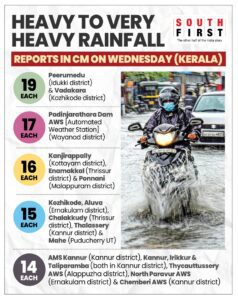Studies show that the monsoon is changing. There is an increase in the frequency of deep clouds and extreme rainfall events.

Monsoon clouds as of 5 July. (IMD)
As rainclouds wrapped Kerala’s highlands, valleys, and coasts, heavy showers lashed the state this week.
“The Southwest Monsoon has been vigorous over Kerala,” India Meteorological Department (IMD) stated on Wednesday. Heavy rainfall in most places is forecast till Saturday, 8 July. On Wednesday, as the rains continued, there was high wind and sudden bursts of rain at several places.
Travelling across the mountains through Nilambur forests through midlands to the south of Kerala on Tuesday, this reporter could see heavy clouds and rain right up to Thiruvananthapuram. State transport drivers said they drove slowly, as the roads were wet and visibility low at several points in the morning.
These rains are driven by an offshore trough (low pressure area) at the mean sea level running from the south Maharashtra coast to the Kerala coast, and circulation over the Bay of Bengal between 4.5 and 5.8 km above mean sea level, and another circulation over the north Andaman Sea between 1.5 and 5.8 km above mean sea level, the IMD said.
“The rainclouds taken away by the Extremely Severe Cyclonic Storm Biparjoy have been brought back by these systems,” Abhilash Sukumarapillai, director of the Advanced Centre for Atmospheric Radar Research (ACARR) at Cochin University of Science and Technology (CUSAT), told South First.
Recent research by CUSAT/ACARR atmospheric scientists showed that the evolution of extreme rainfall events on the southwestern coast are linked to the warming of the south-central Arabian sea, increased difference in sea surface temperature between north and south Arabian Sea, low pressure over the Bay of Bengal four days before the event, and circulation at the mid-troposphere, 4–7 km above the earth, that influences wind direction and clouds.
 “Under the influence of these factors, moisture-laden winds shift from the northwest coast to the southwest coast of India. These factors trigger deep clouds responsible for intense rains over the coast of Kerala,” explained doctoral researcher AV Sreenath.
“Under the influence of these factors, moisture-laden winds shift from the northwest coast to the southwest coast of India. These factors trigger deep clouds responsible for intense rains over the coast of Kerala,” explained doctoral researcher AV Sreenath.
“There is intraseasonal variability of the monsoon. There are active and break phases. Now we are in the active phase,” Madhavan Nair Rajeevan, a monsoon expert at the National Centre for Earth Science studies, told South First as the rains began.
“After a few days we may enter into a break or weak phase,” he added.
“There were rains in most parts of Kerala and Lakshadweep, the IMD said on Wednesday. Their graphs showed that the daily average rainfall crossing the 1971–2020 long-term average figure. The rainfall bar crossed the red curve (indicating daily average figures) for three continuous days, and this is the classical active spell,” Abhilash said.
For heavy to very heavy rainfall in cm, as reported by the IMD on Wednesday, See Graphic.
ACARR scientists cite studies to show that the monsoon is changing. There is an increase in the frequency of deep clouds and extreme rainfall events.
Trend analysis shows less events of low rainfall and more very heavy (heavier than 95 percent of the events) to extremely heavy (heavier than 99 percent of the events).
Indian summer monsoon rainfall during 1991–2015 was marked by a smaller number of wet days more dry days; less light and moderate rainfall days and an increase in extreme (heavy and very heavy) rainfall days.
As South First had reported earlier, citing farmers in Wayanad, that such erratic rain could affect sowing, plant growth, and eventually crop yield.
There are concerns that the delayed rains with heavy spells could be bad for farming with rain deficit continuing in Wayanad and elsewhere.

Jul 26, 2024

Jul 26, 2024

Jul 25, 2024

Jul 25, 2024

Jul 25, 2024

Jul 24, 2024